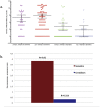Novel somatic mutations to PI3K pathway genes in metastatic melanoma
- PMID: 22912864
- PMCID: PMC3422312
- DOI: 10.1371/journal.pone.0043369
Novel somatic mutations to PI3K pathway genes in metastatic melanoma
Abstract
Background: BRAF(V600) inhibitors have offered a new gateway for better treatment of metastatic melanoma. However, the overall efficacy of BRAF(V600) inhibitors has been lower than expected in clinical trials, and many patients have shown resistance to the drug's effect. We hypothesized that somatic mutations in the Phosphoinositide 3-Kinase (PI3K) pathway, which promotes proliferation and survival, may coincide with BRAF(V600) mutations and contribute to chemotherapeutic resistance.
Methods: We performed a somatic mutation profiling study using the 454 FLX pyrosequencing platform in order to identify candidate cancer genes within the MAPK and PI3K pathways of melanoma patients. Somatic mutations of theses candidate cancer genes were then confirmed using Sanger sequencing.
Results: As expected, BRAF(V600) mutations were seen in 51% of the melanomas, whereas NRAS mutations were seen in 19% of the melanomas. However, PI3K pathway mutations, though more heterogeneous, were present in 41% of the melanoma, with PTEN being the highest mutated PI3K gene in melanomas (22%). Interestingly, several novel PI3K pathway mutations were discovered in MTOR, IRS4, PIK3R1, PIK3R4, PIK3R5, and NFKB1. PI3K pathway mutations co-occurred with BRAF(V600) mutations in 17% of the tumors and co-occurred with 9% of NRAS mutant tumors, implying cooperativity between these pathways in terms of melanoma progression.
Conclusions: These novel PI3K pathway somatic mutations could provide alternative survival and proliferative pathways for metastatic melanoma cells. They therefore may be potential chemotherapeutic targets for melanoma patients who exhibit resistance to BRAF(V600) inhibitors.
Conflict of interest statement
Figures



References
-
- Alcala AM, Flaherty KT (2012) BRAF inhibitors for the treatment of metastatic melanoma: clinical trials and mechanisms of resistance. Clinical cancer research : an official journal of the American Association for Cancer Research 18: 33–39. - PubMed
-
- Gray-Schopfer V, Wellbrock C, Marais R (2007) Melanoma biology and new targeted therapy. Nature 445: 851–857. - PubMed
Publication types
MeSH terms
Substances
Grants and funding
LinkOut - more resources
Full Text Sources
Medical
Research Materials
Miscellaneous

